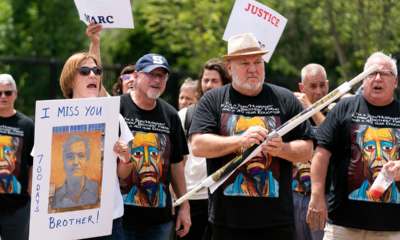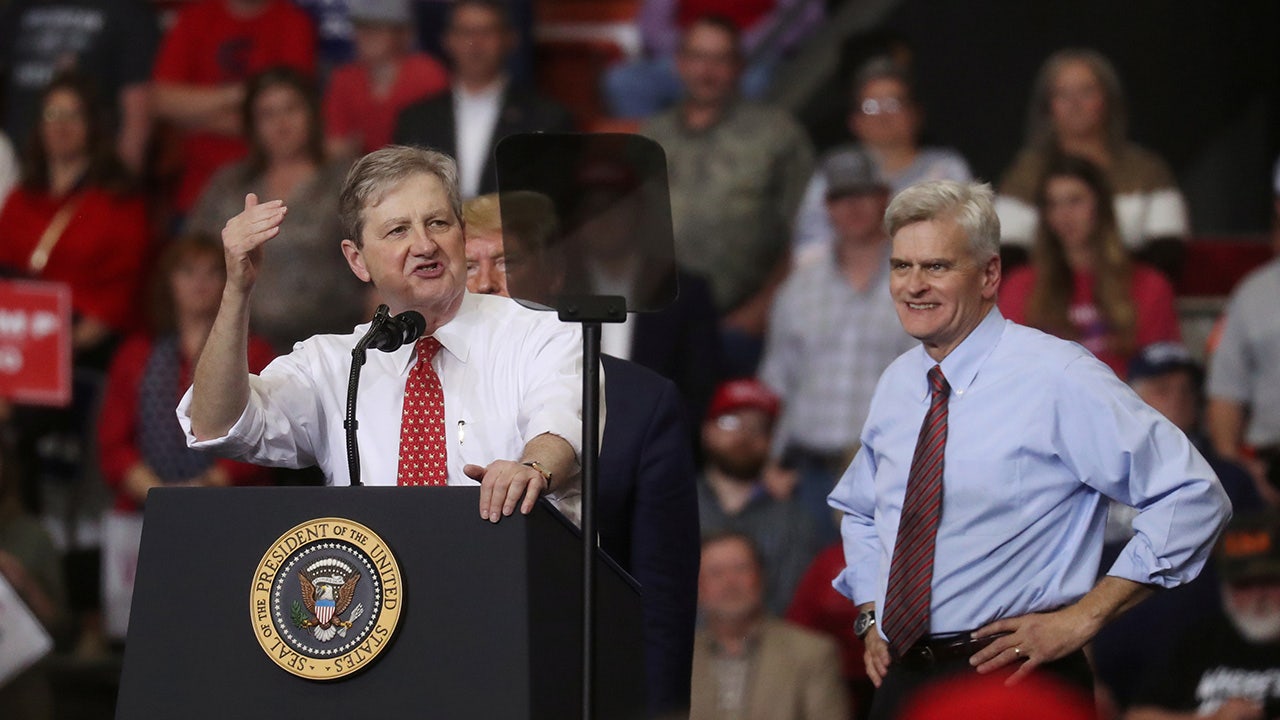Sports
Lions take down 49ers as Dan Campbell's 'full throttle' mindset saw starters play entire game
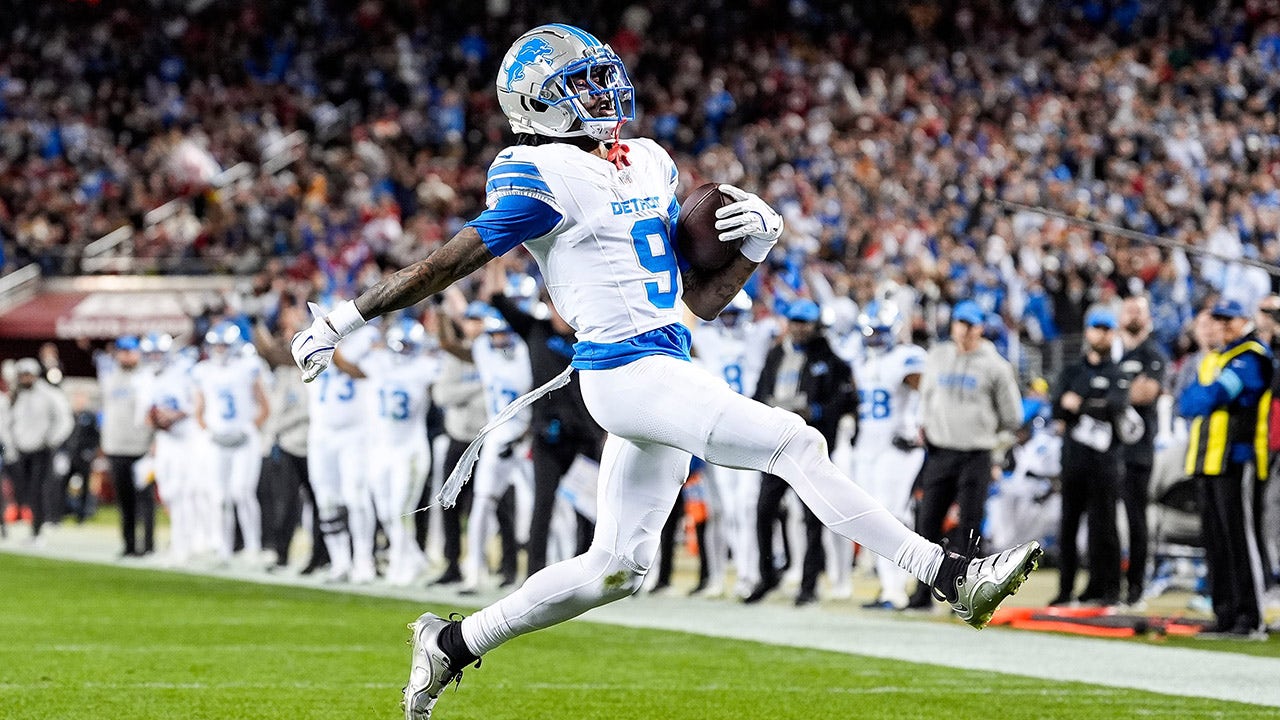
The Detroit Lions technically didn’t need to win Monday night’s matchup with the San Francisco 49ers, begging the question of whether head coach Dan Campbell would pull his starters at some point in this game.
But, as Campbell has shown us too many times in the past, he’s never going to let up no matter the situation. And after saying it will be “full throttle” on the West Coast this week, he meant it.
The Lions took down the 49ers, 40-34, where the starters played throughout the game on both sides of the ball.
Detroit Lions quarterback Jared Goff (16) makes a pass against San Francisco 49ers during the first half at Levi’s Stadium in Santa Clara, Calif. on Monday, Dec. 30, 2024. (IMAGN)
Detroit remembers well what happened in January at Levi’s Stadium, having blown a massive first-half lead in the NFC Championship Game. So, there was a bit of revenge in this one despite the 49ers being mathematically eliminated from playoff contention.
Jared Goff passed his way to three touchdowns, going 26-of-34 for 303 yards in another stellar performance for the Lions. He found Sam LaPorta and Amon-Ra St. Brown, but by far the best Lions touchdown was yet another lateral play that worked to perfection.
Earlier this season, it was St. Brown dishing it back to Jahmyr Gibbs for the score against the Arizona Cardinals. Well, the same concept was used as St. Brown caught the quick slant from Goff, but the speedy Jameson Williams came behind him and took the ball to the house on a 41-yard run.
2024-25 NFL PLAYOFF ODDS: EVERY TEAM’S ODDS TO MAKE THE POSTSEASON
At that point, it was a 14-13 game, as Brock Purdy and the 49ers’ offense were clicking well to start this game.
Purdy orchestrated three straight touchdown drives against Detroit to open it up, including a strike to rookie Ricky Pearsall on the opening drive of the game. Then, he needed just six plays on the next drive to find Kyle Juszczyk from nine yards out, and the third touchdown was a scramble by Purdy for nine yards to make it 21-13.
However, the second half saw a Lions dominance that has been felt by many teams this season. It began with a quick opening drive that saw LaPorta get in the end zone from six yards out. But, once again, the 49ers answered with a touchdown of their own, as Deebo Samuel found his way into pay dirt to retake the lead, 28-21.

San Francisco 49ers quarterback Brock Purdy (13) celebrates with tight end George Kittle (85) after scoring a touchdown against the Detroit Lions during the second quarter at Levi’s Stadium. (Kyle Terada-Imagn Images)
This back-and-forth battle was only going to fall off the rails when one team forced the issue, and that’s exactly what Aaron Glenn’s Lions defense did after making it 28-24 with a Jake Bates field goal.
Kerby Joseph, who now leads the NFL in interceptions this season, picked off a Purdy throw that sailed over Pearsall’s head. And when Detroit creates turnovers, points usually follow.
That’s when St. Brown’s touchdown, a four-yard catch, came for the Lions, who went for it on fourth-and-goal to take a 31-28 lead. The ensuing drives saw a missed Jake Moody field goal from 58 yards out, followed by yet another Joseph interception, which gave him nine for the year.
That interception led to the nail in the coffin, as Gibbs, who rushed for 117 yards on just 18 carries, broke a 30-yard touchdown run to add to the Lions’ offensive onslaught.
Purdy was eventually injured on the final 49ers drive of the game, but backup Josh Dobbs did add to the score with a scramble touchdown run to make it a 40-34 game. But the onside kick attempt to keep the game alive was recovered by Detroit.

Detroit Lions wide receiver Jameson Williams (9) runs for a touchdown against San Francisco 49ers during the first half at Levi’s Stadium in Santa Clara, Calif. on Monday, Dec. 30, 2024. (IMAGN)
Looking more at the stat sheet, St. Brown led the Lions with eight receptions for 60 yards, while LaPorta finished with 64 yards on six catches.
Purdy would’ve had a brilliant performance if it wasn’t for the two interceptions, as he was 27-for-35 for 377 yards with three touchdowns. Pearsall had 141 receiving yards for the game-high on eight catches, while George Kittle matched his eight receptions for 112 yards. Jauan Jennings also finished with 67 yards on seven catches.
Follow Fox News Digital’s sports coverage on X, and subscribe to the Fox News Sports Huddle newsletter.

Sports
Can a team led by Division II transfers become college hoops’ most dangerous mid-major?

KANSAS CITY, Mo. — Drake head coach Ben McCollum paced in the coaches’ locker room before speed-walking in to address his team.
His assistants had told him the players were a little quiet during warmups for the Wildcat Classic, a mid-December game against Kansas State in downtown Kansas City. Star point guard Bennett Stirtz attended the event they were about to play in as a fan a year ago. Isaiah Jackson, whose childhood home is 15 minutes from T-Mobile Center, had watched many games in the building but never stepped on the floor. When he walked through the tunnel for the first time, he took out his phone and captured the moment, then FaceTimed his parents after practice so they could see.
Stirtz and Jackson are two of the four starters who followed McCollum from Division II Northwest Missouri State when he was hired by Drake this offseason. They’d played in big games, but no environment like this. So McCollum decided to recycle a speech he’d given before the 2021 Division II national title game when he’d had a similar feeling.
“It’s always fascinating in these kinds of environments, what some people can do and what some people quite frankly can’t do, that they can do in a regular environment,” McCollum said.
He told his players to imagine there was a balance beam on the floor — four inches wide, five meters long. Could they walk across it? “Hell yeah you can,” he said.
Now raise it 10 feet in the air. You may think twice, but most could still make it.
Now what if it was 150 feet in the air?
“The same balance beam that you just told me you could walk across when it was on the ground because there was no repercussions to it, all of a sudden it lifts a little bit and you can’t walk across it anymore? Why?” McCollum asked. “Because you lost the ability to walk? No. You can still do that. Because you’re distracted by everything else around you.”
McCollum’s point: Block it out — the crowd, the noise — and just put one foot in front of the other.
A few hours later, the Bulldogs sprinted back into that locker room, knocking off a Big 12 team on a shot by Stirtz with 3.4 seconds left in overtime.
Drake opened 2025 as one of the final four undefeated teams in Division I, playing with a confidence reinforced by the results its leaders brought from the D-II ranks. The Bulldogs faced their first setback Wednesday, dropping their Missouri Valley Conference road opener 74-70 to UIC, but they’re off to a 12-1 start that no one saw coming, with three wins over high-major programs.
“They look good on film, but when you watch them in person, they’re even better,” said Vanderbilt coach Mark Byington, who called McCollum after Drake beat Vandy in November to ask if he’d get on a Zoom and talk through how he did it. “And what they’re better at in person is some details that you might not catch by watching film. And then when you see them in person, they hit every single detail.”
In 15 seasons at Northwest Missouri State, McCollum won 12 regular-season conference titles and four national titles. Long before he was coaching at their level, Division I coaches would mention that they’d been studying Northwest Missouri State’s offense. They expected McCollum to succeed in D-I, but not this much and this fast.
Meanwhile, McCollum’s players expect to win because they know McCollum is going to put them in the right places and always know exactly what to say.
“They’re a well-tuned machine,” Byington said. “I shook his hand after our game and told him this group can make a deep run in the (NCAA) Tournament. Not just win a game; they can make a run.”
McCollum won four D-II national championships at Northwest Missouri State, including three in a row. (Cody Scanlan / The Register / USA Today Network via Imagn Images)
Why did it take so long for McCollum to get a Division I job?
“I’m a slow trigger by nature,” McCollum said, “because I evaluate every decision quite a bit.”
In the last few years, McCollum was in the mix for several low- and mid-major openings, but he was always hesitant to move his family. Drake was a job he’d always eyed — he’s originally from Iowa, and it’s a program with a winning history in a strong league — but it still took him five days to accept after it was offered. “We had a good setup,” McCollum said. “And, you know, your culture doesn’t necessarily travel.”
That wasn’t necessarily true, because all it took to get three of his returning starters to go with him was one visit each to his office. If he were to go, would they come along? Stirtz, Jackson and Daniel Abreu said yes immediately.
Stirtz and Jackson both wanted their shot at D-I, too. They had the same two offers out of high school: William Jewell College and Northwest Missouri State.
Abreu, who did have two D-I offers in high school (Abilene Christian and Jacksonville), was ready for a challenge. “I was getting bored of the scouts after year two, playing the same teams over and over again,” Abreu said. “I can’t believe (McCollum) did it for that long.”
Those three yeses got McCollum off to a head start building the lineup he needed. Stirtz is the point guard who can do a little of everything; Jackson is the distributor and lockdown defender; the 6-6 Abreu plays with a physicality that allows him to guard up. McCollum had a big on the way in Cam Manyawu, a Wyoming transfer who followed assistant Bryston Williams to Drake.
The final piece needed was a shooter. McCollum had one at Northwest Missouri State but thought he was finished playing. Mitch Mascari had his MBA after five years in Maryville and had accepted a job as a credit analyst in asset management at First Trust Portfolios in Wheaton, Ill. He was supposed to start in two weeks, but after McCollum accepted the Drake job, Mascari started thinking maybe he too wanted his shot at D-I and put his name in the transfer portal on the final day it was open. McCollum called him right away, and Mascari asked McCollum what he thought he should do.
“Naturally, when you coach somebody for five years, you build up a level of trust and whatever probably opinion that I would have given him, he probably would have done it and listened,” McCollum said. “And so I couldn’t give him my opinion. I could just give him the positives and negatives of both. And then it was ultimately his decision to make and he chose to come and play.”
The one starter McCollum could not bring with him was Wes Dreamer, the conference player of the year who is now the leading scorer for a professional team in Germany. That meant McCollum had to do more teaching than his former Bearcats had witnessed before, and he had to rethink the team’s style of play.
Making this hot start even more unlikely is the possibility that McCollum may have as little depth as he’s ever had. Mascari has played every minute in five of the 13 games. Stirtz has come off the floor twice in the 11 games against D-I opponents — both in the final minute of comfortable wins over Stephen F. Austin and Belmont.
The offense is built around getting Mascari 3s and Stirtz a gap to drive, with Abreu making the occasional 3 and always looking for openings to cut. Whichever big is on the floor is a roller/cutter, and Jackson distributes while also providing timely drives or cuts to the basket. The former Bearcats have found in D-I that sometimes it takes more time to find a quality look, but they will exhaust every opportunity to get a great shot.
“We have to move it,” McCollum said. “All five guys have to connect to be able to create windows and avenues, to be able to get to the paint and get below the defense. We’ve had to invest in five or six different ways, where it’s just like if they guard this, then we have to go to this and this and that.”
Jackson says the difference between Division II and Division I is that these big schools play at a quicker pace and take “early, average shots.” McCollum has always believed that to beat good teams, you’re going to have to score against a set defense.
“We play a slower tempo because we don’t take bad shots, and we won’t take bad shots,” McCollum said. “We refuse to take them. And so it naturally slows the game down.”
McCollum’s players always feel like they have the answers to the test, and the coach has always been willing to scrap plans if the opponent throws a curveball. The offense is like a decision tree.
“A lot of our offense is predicated on how the defense reacts,” Mascari said. “So if a defense is reacting in a different way than we anticipated, we’re just going to do something else. Sometimes we’re walking down the floor, and we have no idea what we’re about to do. So how is the defense supposed to?”
Drake may lead the country in shot clock violations, which is part of the reason Drake is turning the ball over at one of the worst rates in college basketball — 20.5 percent of its possessions against D-I competition. The Bulldogs would rather run out the clock than take a mediocre shot, and they stay composed when the seconds tick away late in a possession. Against Vandy, they had three shot clock violations. “That never fazed them,” Byington said, noting Drake also made three late-clock 3s.
Defensively, the Bulldogs seem to rarely ever make a mistake, and McCollum is meticulous in demonstrating how to guard every action they will see, from the footwork to body position to where to be on the floor. He gives his players easy cues to remember.
“It’s not really what you know,” McCollum said. “It’s what they can comprehend and then execute.”
This may be the most impressive stat for Drake this season: Without one player taller than 6-8 in the rotation, Drake ranks 15th nationally in defensive rebounding rate and 17th in offensive rebounding rate. After getting out-rebounded by Stephen F. Austin in its first game against a Division I opponent, the Bulldogs have won the battle of the boards every game since. That aspect of this start astonishes even McCollum.
“They’re just destroying people on the boards,” McCollum said. “Defensive rebounding, we’ve always been No. 1 in the country (in Division II). Offensive rebounding, we’ve just been physical. We just go get the ball. Little chip on our shoulder.”
Three years ago Northwest Missouri State entered the season as the defending national champs with four starters returning. The Bearcats had gone 97-3 the previous three seasons. It was star guard Trevor Hudgins’ senior season.
And McCollum wanted them to fail.
Every preseason he puts his team through an exhausting conditioning test. Every player has to run 20 line drills and 20 down-and-backs in 20 minutes. You have to do both in one-minute windows and can’t start again until the beginning of each minute. If you don’t pass, you try again the next day. Before the test three years ago, the Bearcats had a hard lift — squats and resistance bands. They were being set up to fail. “Our legs were done,” Jackson said.
Jackson was the only player who made time, but McCollum still made him run the next day with all of his teammates because he wanted to see them all pass it together.
“They need to teach themselves to respond,” McCollum said. “You don’t just respond to failure well. You’ve got to develop that habit through failing and then figuring out the response to it.”
Against K-State, Drake found failure. After leading 29-9 early, K-State started to chip away late in the first half, going on a 14-2 run. “That crowd popped,” Stirtz leaned over to tell Mascari at halftime.
Mascari had been on fire, making all six of his 3s in the first half. But K-State mostly took him away in the second half, face-guarding him and Stirtz. Midway through the half, K-State sharpshooter Brendan Hausen got a clean look for the first time and buried it to tie the game. It felt like K-State was in control, with Drake looking tired and hopeless in the half court.
With 23.9 seconds left, Abreu went to the free-throw line, the Bulldogs’ first loss looming if he missed. During the under-16 timeout of the second half, Drake had broken its huddle early, and Abreu was joking with a security lady stationed at the free-throw line. McCollum affectionately calls him Buddy the Elf because he’s always in a good mood. A day earlier, Abreu said that he never watches basketball — he prefers movies — and his ignorance of the basketball world is a gift. “The nerves aren’t there because I just don’t know,” he said.
He buried both free throws to force overtime.
“They’re tough. I mean they’ll outlast ya,” McCollum said. “That’s the thing, like there’s a level of toughness. There’s a level of outlast. There’s a level of, you know, who’s going to take it further? And we’ve just tried to train them to be able to create those habits to take it a little bit further and fight a little bit more.”
In overtime, Stirtz found the little bit more.
He scored five of Drake’s first seven points in OT, and after K-State’s Coleman Hawkins buried a 3 with 12.3 seconds left to tie the game, Stirtz got the inbound pass and calmly jogged the ball up the floor. Drake set up with all four teammates lined up on the baseline and let Stirtz go to work. Stirtz crossed over, got Hausen on his heels and buried the game-winner.
That was a response.

Stirtz and the Bulldogs have been undaunted by high-major competition so far. (Jay Biggerstaff / Imagn Images)
The hero returned to his locker stall and sat. He leaned back, hands on his lap and stared straight ahead in a daze.
Stirtz is a K-State fan. His grandparents are football season-ticket holders. Both his older brothers went to K-State, and his younger brother plans to enroll there next year. His mom wore a K-State shirt under her Drake shirt in support of Stirtz’s girlfriend, a K-State dancer who watched his game winner from the opposite baseline. In high school, Stirtz sent his film to K-State coaches. Once he got his Northwest Missouri State offer, the only ones he would have considered were Division I offers. Those never came. When Stirtz committed to the Bearcats, McCollum told friends he thought he’d stolen one.
Byington marveled at how Stirtz and the three other former Bearcats ever ended up at that level: “Those guys are probably starters on most SEC teams.”
Hyperbole? Maybe. But not with Stirtz. He’s so good that NBA scouts are starting to take notice. And college basketball is taking notice of the Bulldogs. They were picked fifth in the Missouri Valley in the preseason coaches’ poll. They were projected to win the league before Wednesday’s loss at UIC, according to Ken Pomeroy’s metrics, and nationally they’ve been on the verge of getting ranked. In this week’s Associated Press poll, they received the second-most votes among teams outside the Top 25.
Stirtz is as unassuming a star as you’ll find. He never celebrates a made bucket. He’s quiet off the floor. But in that overtime, Stirtz wanted the ball and he wasn’t going to let the Bulldogs lose. Against the school he had dreamed of playing for, Stirtz realized the fact that he was being face-guarded meant the Wildcats didn’t think they could guard him, and he started to believe it himself.
“I ain’t one for individual s—,” McCollum told his team once he got to the celebratory locker room, “but damn, that’s a big shot.”
Then McCollum reminded his players of the satisfaction of what they’d just accomplished. He nearly went into the next challenge, before catching himself, “I’m not even going to ruin the moment,” he said. “Let’s just get our prayer and get out of here.”
The Bulldogs knelt, and Abreu delivered the perfect line. “Dear Heavenly Father, thank you for Bennett.”
Stirtz then headed to the news conference, where he informed the media that his game winner was the first buzzer beater of his life. Technically, there were still those 3.4 seconds on the clock, but that’s just about the only flaw in this script, which somehow keeps getting better.
(Photo: Mitchell Layton / Getty Images)
Sports
Sugar Bowl's corporate sponsor CEO slammed for 'addiction to divisiveness' statement after terror attack

Allstate CEO Tom Wilson ignited a firestorm of backlash on social media Thursday with a video statement addressing Wednesday’s terror attack in New Orleans that killed more than a dozen people.
Wilson’s statement came ahead of the Sugar Bowl, of which Allstate is the official corporate sponsor, after the game was postponed to Thursday due to the attack. In the video, Wilson suggested Americans have an “addiction to divisiveness” and must “accept people’s imperfections and differences.”
“Our prayers went to victims and their families. We also need to be stronger together by overcoming an addiction to divisiveness and negativity. Join Allstate working in local communities all across America to amplify the positive, increase trust and accept people’s imperfections and differences. Together we win,” Wilson says in the video.
Wilson’s words sparked outrage among social media users. The suspect has been identified as 42-year-old Shamsud-Din Jabbar. The FBI is working to determine Jabbar’s “potential associations and affiliations with terrorist organizations,” after an ISIS flag was found affixed to the truck.
Political activist Charlie Kirk spoke out against Wilson for his comments amid Jabbar’s suspected ties to ISIS.
Sean Davis, CEO and co-founder of conservative magazine The Federalist, suggested it’s time to cancel Allstate insurance plans.
Sports content creator Jon Root spoke out against Wilson and mocked his comments.
SUPERDOME WELCOMES SUGAR BOWL FANS AFTER NEW ORLEANS TERROR ATTACK
Injury lawyer Adam Loewy not only condemned Wilson’s statement, he called out Allstate as a company in response to the controversy.
Other smaller social media users have expressed their own grievances and intent to end their insurance plans in response to Wilson.
“What was Allstate thinking with that statement[?] I have just canceled my policy and signed up with State Farm,” one user wrote.
“That limp-wristed Allstate commercial about the terrorist attack is just what I needed to know that I won’t give them my business,” another wrote.
And one user even called the commercial “The worst, most ill-conceived of the college football season.”
Jabbar’s younger brother told the New York Times that he and his Army veteran brother were raised Christian in Beaumont, Texas, before the now-deceased attacker converted to Islam as an adult.
“What he did does not represent Islam,” the younger brother said. “This is more some type of radicalization, not religion.”
Retired FBI agents Scott Duffey and Chris Swecker told Fox News Digital that Wednesday’s attack could embolden ISIS, other terrorist groups or individuals who have been radicalized.
“This is a time where ISIS is under extreme stress and their existence is being threatened in Syria and elsewhere. It would make sense for them to double down on their message to radicalize Americans to put them into action and activate any cells that they have in place,” Swecker said.
Days before the attack, a pro-ISIS outlet called on Muslims living in the U.S., Europe and Russia to conduct attacks on New Year’s Eve.
“Oh monotheists in Europe, America, Russia and other lands of the Crusaders, we know that you are eager to join your brothers in the land of Jihad, but the paths have been cut off for you,” a translated version of the post read on Sunday. “The Crusaders are among you. Their security has been prolonged, and your brothers are being killed.
“The time has come to take out the swords from their sheaths and to hamstring the horses in their places that Allah loves and is pleased with,” the post continued. “They are preparing for the feast of their polytheism, so turn their feast into mourning and their joy into a calamity.”
The outlet asked Muslims, or “Crusaders,” if they felt safe in their homes as their brothers and sisters were in detention centers and camps before calling on them to “repeat the attack on them and repeat the days of those who preceded you on this path.”
The attack in New Orleans comes nearly two weeks after a suspected terror attack on a Christmas market in Germany.
Follow Fox News Digital’s sports coverage on X and subscribe to the Fox News Sports Huddle newsletter.
Sports
'It's the only show in town': UCLA will face far more hostile road crowds in Big Ten
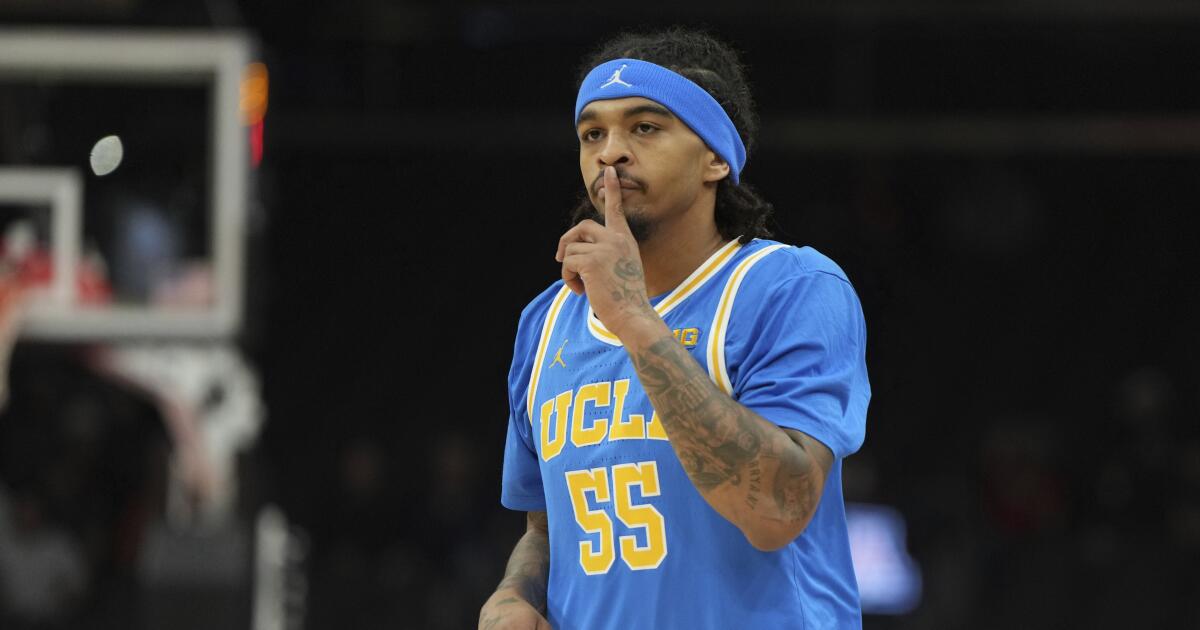
When Tyler Bilodeau, Kobe Johnson and the other UCLA starters approach center court for tipoff against Nebraska on Saturday inside Pinnacle Bank Arena, the roars from a sold-out crowd washing over them, one thing will be thunderously clear.
They’re not in Gill Coliseum, Maples Pavilion or any of the other sleepy Pac-12 arenas anymore.
Noise will be a constant companion as UCLA navigates its first Big Ten schedule. Nine conference teams are averaging at least 10,000 fans for home games, with Indiana’s average of 16,514 leading the way. Purdue ranks second with 14,876 fans per home game, followed closely by Nebraska (14,848), Michigan State (14,797) and Illinois (14,789).
“I don’t think I can name a single Big Ten stadium where their fans don’t come and, like, show out and support and they’re talking trash,” said UCLA junior guard Skyy Clark, a veteran of the experience after having spent his freshman season at Illinois. “It definitely gets loud and rowdy, so it’s a fun environment to play in.”
Well, maybe not always for the visitors.
Nebraska (11-2 overall, 1-1 Big Ten) has won 19 consecutive games on its home court during a streak that began in December 2023. With a victory over the No. 15 Bruins (11-2, 2-0), the Cornhuskers would tie the school record of 20 straight home wins they set twice previously.
UCLA coach Mick Cronin understands the challenge that awaits after having taken Cincinnati to Pinnacle Bank Arena in December 2014, when his Bearcats lost in double overtime. At the time, Cronin called the 15,147-seat facility “probably, outside of Louisville, the best arena I’ve ever been in.”
The atmosphere Saturday will certainly be more raucous than what the Bruins experienced in the Pac-12, where some libraries might have been louder than the basketball arenas.
Often it seemed as if the wrestling and basketball banners hanging from the rafters inside Oregon State’s Gill Coliseum outnumbered the fans.
Washington State players once made a habit of venturing into the stands to personally thank fans who showed up inside Beasley Coliseum, the goodwill gesture needing only a few minutes to complete.
UCLA guard Lazar Stefanovic looks to pass the ball during a relatively quiet game at Stanford on Feb. 7.
(Jeff Chiu / Associated Press)
At Maples Pavilion, UCLA blue often eclipsed Stanford red.
“There’s some schools — obviously we’re not in their league anymore — you go play in those places and there’s 1,000 people and it’s cold and you’re paranoid because your guys can’t get going, there’s just no energy in the building,” Cronin said this week.
Arizona was the only Pac-12 team to average at least 10,000 fans for home games during the conference’s final season. Oregon State, Stanford and Washington State averaged fewer than 4,000 fans, with California barely topping that threshold at 4,022.
There will be a carryover effect in the Big Ten given that all four newcomers from the Pac-12 rank in the bottom five in home attendance, with USC’s average of 3,872 the lowest and UCLA ranking next to last with an average of 4,830.

UCLA guards Kobe Johnson (0), Lazar Stefanovic (10), Dylan Andrews (2) and Skyy Clark (55) celebrate beating Gonzaga at the Intuit Dome in Inglewood on Dec. 28.
(Allen J. Schaben / Los Angeles Times)
The Bruins can expect more than double those figures almost every time they board a plane for the Midwest or the East Coast.
“In those college towns,” Cronin said, “it’s the only show in town, so they get great attendance. … So the energy won’t be a problem in the building in those places. You better play with toughness, you better travel your defense because teams with home crowds like that tend to play harder and I think it’s fool’s gold to think you’re going to go into those type of places and score 80 points.”
The Bruins might also want to pack their winter coats. The forecast for Lincoln, Neb., on Saturday calls for a high of 24 degrees, giving Cronin a chance to use the ski mask and gloves his brother, Dan, bought him for Christmas.
“I was like, ‘Yo, man, I live in Southern California,’ ” Mick Cronin said, “and he’s like, ‘You’re in the Big Ten.’ How about that? The guy’s a comedian.”
Injury updates
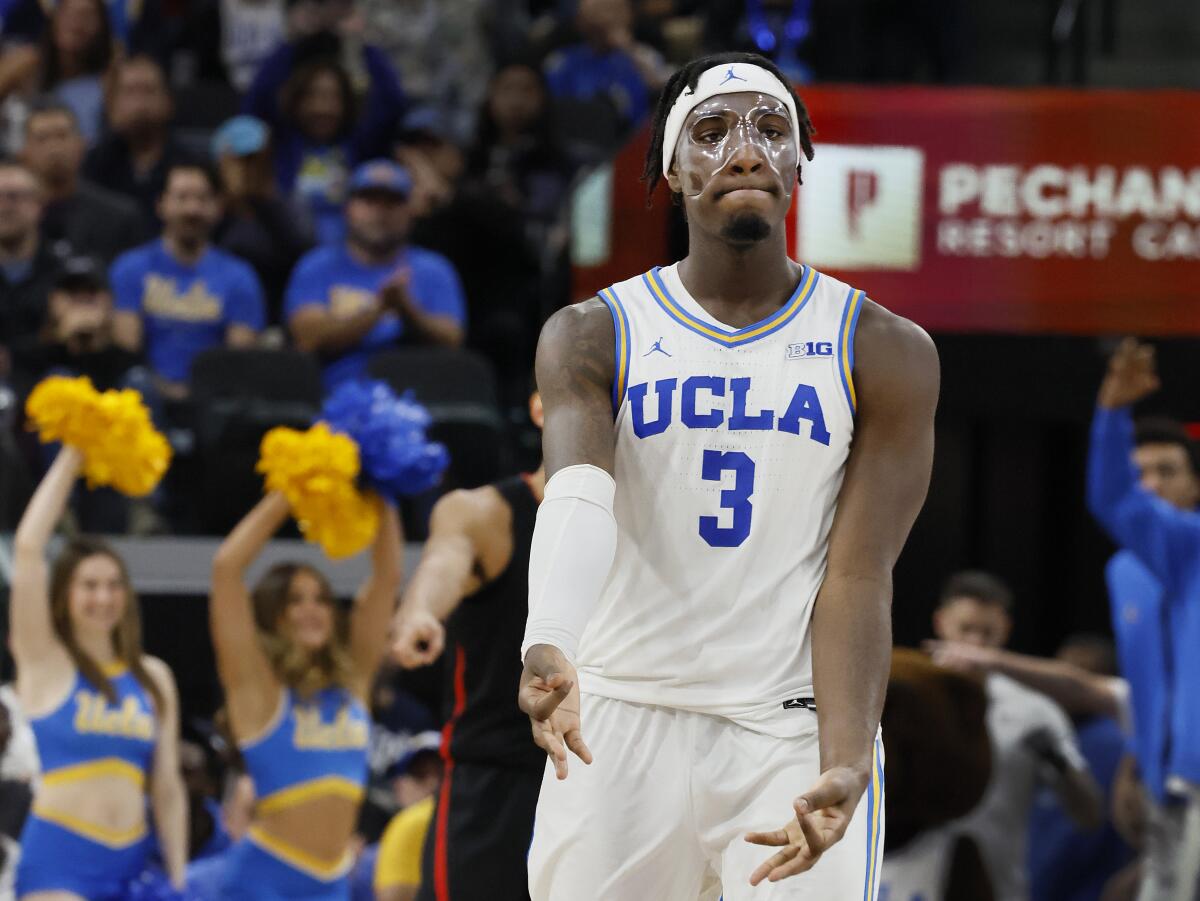
UCLA’s Eric Dailey Jr., wearing a face mask, relishes the moment after making a three-pointer against Gonzaga at the Intuit Dome on Dec. 28.
(Allen J. Schaben / Los Angeles Times)
Cronin said forward William Kyle III was probably out for the game against Nebraska but could return as soon as Tuesday against Michigan after undergoing surgery for an undisclosed condition.
Forward Eric Dailey Jr. is expected to wear a mask “for the foreseeable future” after absorbing a shot to the face against North Carolina last month, Cronin said.
In his first game wearing the mask, against Gonzaga, Dailey made four of five three-pointers. “He may not take it off the rest of the year,” Cronin cracked.
Etc.
Former UCLA forward Berke Buyuktuncel is averaging 7.9 points and a team-leading 6.6 rebounds in his first season at Nebraska. “I’m happy for him,” Cronin said. “He’s definitely gotten stronger and I think he fits into what they do.” Bruins forward Lazar Stefanovic said he looked forward to reuniting with his former roommate. “The thing I loved about him was when we would play video games, he would make, like, all the jokes and stuff and everybody in the apartment would have a lot of fun with it,” Stefanovic said. “And he was good at video games.” … UCLA made 42.9% of its three-pointers in December, raising its accuracy from long range for the season to 37.1%. “The advantage we have in our starting lineup,” Cronin said, “is everybody can shoot.”
-
/cdn.vox-cdn.com/uploads/chorus_asset/file/25672934/Metaphor_Key_Art_Horizontal.png)
/cdn.vox-cdn.com/uploads/chorus_asset/file/25672934/Metaphor_Key_Art_Horizontal.png) Technology1 week ago
Technology1 week agoThere’s a reason Metaphor: ReFantanzio’s battle music sounds as cool as it does
-

 Business1 week ago
Business1 week agoOn a quest for global domination, Chinese EV makers are upending Thailand's auto industry
-

 Health5 days ago
Health5 days agoNew Year life lessons from country star: 'Never forget where you came from'
-
/cdn.vox-cdn.com/uploads/chorus_asset/file/24982514/Quest_3_dock.jpg)
/cdn.vox-cdn.com/uploads/chorus_asset/file/24982514/Quest_3_dock.jpg) Technology5 days ago
Technology5 days agoMeta’s ‘software update issue’ has been breaking Quest headsets for weeks
-

 World1 week ago
World1 week agoPassenger plane crashes in Kazakhstan: Emergencies ministry
-

 Politics1 week ago
Politics1 week agoIt's official: Biden signs new law, designates bald eagle as 'national bird'
-

 Business2 days ago
Business2 days agoThese are the top 7 issues facing the struggling restaurant industry in 2025
-

 Politics1 week ago
Politics1 week ago'Politics is bad for business.' Why Disney's Bob Iger is trying to avoid hot buttons


